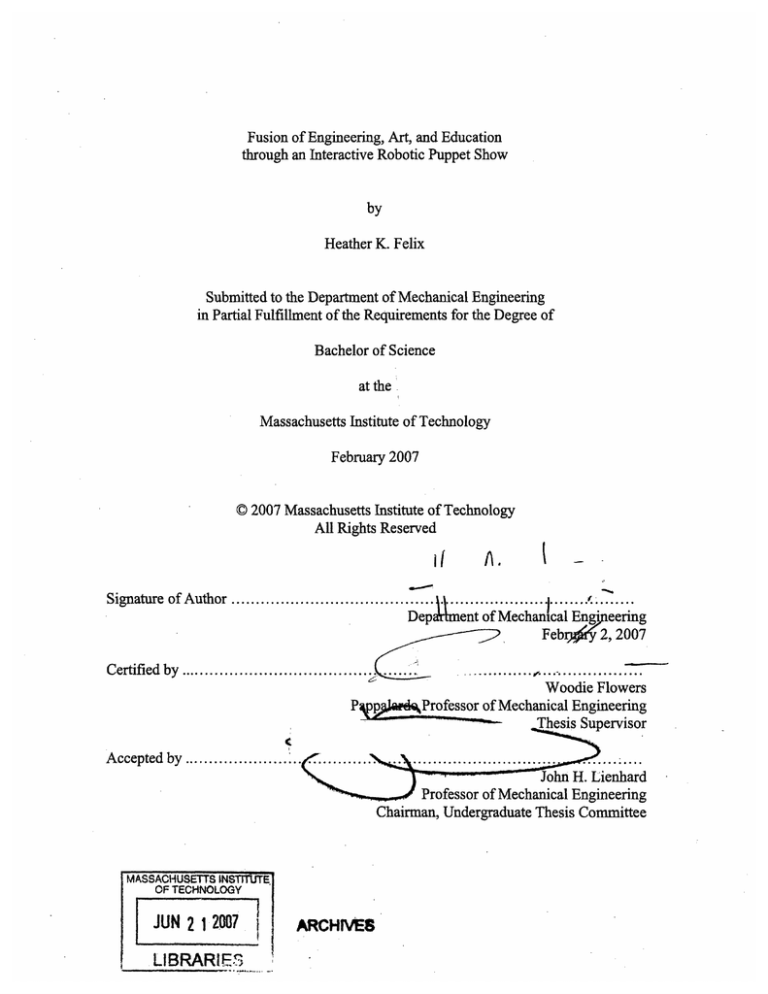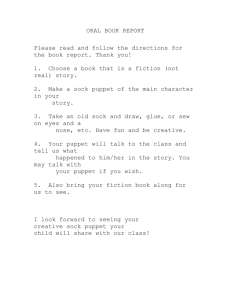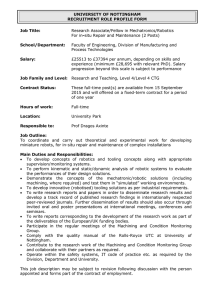Fusion of Engineering, Art, and Education by Heather K. Felix
advertisement

Fusion of Engineering, Art, and Education through an Interactive Robotic Puppet Show by Heather K. Felix Submitted to the Department of Mechanical Engineering in Partial Fulfillment of the Requirements for the Degree of Bachelor of Science at the Massachusetts Institute of Technology February 2007 C 2007 Massachusetts Institute of Technology All Rights Reserved it Signature of Author ....................................... I ........................ ........ Depa dment of Mechamcal Engi eering Febr 2, 2007 C ertified by ....................................... . . P a Accepted by ........... .................................... ..................... John H. Lienhard Professor of Mechanical Engineering Chairman, Undergraduate Thesis Committee MASSACHUSETTS INSTITUTE OF TECHNOLOGY JUN 2 12007 LIBRARIE.f .............. ... ............ Woodie Flowers oProfessor of Mechanical Engineering Tesis Supervisor ARCHIVES Fusion of Engineering, Art, and Education through an Interactive Robotic Puppet Show by Heather K. Felix Submitted to the Department of Mechanical Engineering on February 2, 2007 in Partial Fulfillment of the Requirements for the Degree of Bachelor of Science in Mechanical Engineering. ABSTRACT In this current age of the Technological Revolution, technical proficiency is not enough for graduating engineers and scientists. Creativity and innovation need to be emphasized and pursued. The Robotic Puppet Show fuses engineering, art, and education all in one. The focus of the project is to promote not only interest in math and science for young women, but it includes art to develop creative thinking. The robotic puppets are powered by Vex motors and servos and operated by remote control. After construction of a robotic puppet, I visited a Boston area high school as a guest speaker to demonstrate the robotic puppet's features and abilities, to talk about engineering as a student and in industry, and to gain feedback from students. The robotic puppet was well-received. Human interaction with the robotic puppet played a large part in the students interest. Future plans for the Robotic Puppet Show include developing more personable robots that interact with students on stage. Results indicate that there is potential for successfully teaching robotics to students in this art/engineering approach to both encourage women to pursue engineering and to develop creative thinking that is much needed in today's changing job market. Thesis Supervisor: Woodie Flowers Title: Pappalardo Professor of Mechanical Engineering Table of Contents Introdu ction ..................................................................................................................... 4 Interest in Project ............................................................................................... ......... 4 Project G oals................................................ ..... ............. 5 Background ...... ................... .................................. 5 Overview ................................ ................ .............. 4 Sim ilar Projects................................................................................................. 6 Methods ....... .... ........................................................ ..... 6 Materials and Tools....................................................... 6 R obot Character and Features.......................................................... ....................... 6 Results .................... .. .. ........... ..................... ....................... 8 H igh School V isit......................... ............. .................... 8 Student Feedback .............. ......... ................................. 8 Conclusions and Recommendations for Future Work ................................................ 9 R eferences .......................................... .......................... ........................ 11 Introduction Interest in Project This project began with the desire to incorporate my engineering and art skills. I have a background in Mechanical Engineering at MIT and personal pursuits in art that range from drawing to sewing to design. I believe that the fusion of art and engineering creates better art and better engineering. Engineering and art should not necessarily be polar opposites but rather, combined to make innovative designs and spur further education. As a woman, I was encouraged in high school by my math teacher to pursue engineering activities and take part in clubs inside and outside school. This was the beginning of the desire for and successful follow through of a career in engineering. Currently as an engineer coming to the end of my undergraduate degree, I look towards middle schools and high schools and ask how better one can reach more females to encourage them to consider and pursue a career path in math, science, and engineering without necessarily neglecting the arts. Overview Today, engineers not only have to be technically proficient, but they also have to be creative and empathetic. By being empathetic to the student, consumer, or peer, one can better design :for their audience. In the high school setting, students attend classes and sometimes participate in science or math based clubs. This robotic puppet projects aims to find an alternative way in which to teach introductory robotics in the high school setting. It is hypothesized that both the art and engineering of the robotic puppet will encourage and inspire young women to pursue and take a greater interest in the math and science fields. I have spent my undergraduate education improving my technical and analytical skills. Though this thesis project I am employing my artistic skills and creative ideas. The robotic puppet also serves to interest young girls into the engineering field without neglecting the artistic and empathetic aspects. However, the puppet show is not limited to girls. I feel that learning should be fun and enjoyable. One should play when learning to gain interest. The robotic puppet is an interactive art sculpture, toy, and challenge. It allows them to have a hands-on interactive experience with robots, but it leaves enough space for them to think creatively. Background Project Go~als The purpose of the robotic puppet is to accomplish two main goals. The first goal is to fuse art and engineering in the building and teaching process of robotics. The second goal is to encourage young women in high school to pursue engineering careers. These two goals are not separate but intertwining. First, creating a robot that is designed to be used in a puppet show, play, or for human interaction, is one way to combine art and engineering. This combination will help produce analytical and creative engineers that are needed in the changing job market. Today there are thousands of engineers graduating from western universities only to find out that companies are now outsourcing technical positions to engineers from Asia or are replacing them with computers. Companies can pay significantly less money for an engineer from Asia that is equally as proficient as his western counterpart. Also, with the increase of technology there is software that can reduce the work needed from technical workers. With the Industrial Revolution came assembly lines and then machinery and robots that eliminated many jobs. Now with the Technological Revolution there are computers and software packages that can analyze data and problem solve. There are programs that do taxes, websites that find legal forms, programs to find houses on the market, and more, eliminating many technically skilled jobs. While not all jobs will be eliminated by outsourcing or technology, it is becoming more evident that graduates need not only technical proficiency but more, they need creativity, innovative ideas, holistic thinking, empathy, and more. This can be thought of as balanced right-brain and leftbrain thinking. The left side of the brain tends to deal with analytical, sequential, logical, verbal thinking while the right side of the brain tends to deal with holistic, visual, and perceptual thinking. With the robotic puppet, students can develop and use engineering skills to build a robust working machine to their personal specifications. Students can also simultaneously develop and use their artistic skills to create characters and stories from their imagination. It is the hope of this project to allow students, both male and female, to develop engineering and art skills jointly rather than independently. This approach will hopefully help to in the development of students to analytically and creatively approach future problems and assignments and be able to better compete in the current job market Secondly, the robotic puppet encourages more women to participate in engineering. There is a disproportionate amount of females in the math and science fields. Math, science, and engineering have predominantly been populated by men. Though the ratio is improving, there is still a large chasm that needs to be filled. Women can not only succeed in these fields, but they can excel in them in this age of technology and outsourcing. Women tend to be more empathetic and right-brained and men tend to be more systematic and left-brained. If more women were to pursue engineering, their empathetic and creative skills would be desired and valued in the current job market. Many of the robotic classes and clubs focus on competition and are successful. The goal of the robotic puppet is not to discourage these competitions, but have an alternative way to approach and build robots that will interest more women. SimilarProjects Robots come in many different forms and serve many different functions. Robots have been implemented in factories and also have written about in science fiction and portrayed in film. Some various uses include manufacturing plants and assembly lines, toys, teaching tools, and more. The Jim Henson Company, Walt Disney Imagineering, and Battlebots are some commercial examples in which robots were used for entertainment. Projects that are similar to this robotic puppet project include the FIRST Robotics Competition, the FIRST Vex Challenge and the FIRST Lego League where high school teams from all over the world compete in an annual competitions. They form groups in their home towns and build robots that can compete and fulfill the annually changing requirements, tasks, and challenges. These competitions encourage students to work in teams to learn about building, programming, and designing their own robots. Methods Materials and Tools Many standard and basic parts are employed in teaching robotics to high school students. Several different kits are available for teaching for different levels. The Vex Robotic Design System is a robotic kit used to create the robotic puppet. The kit includes various media such as aluminum, motors, servos, switches, fasteners, gears, wheels, a programmable microcontroller, a remote control, and various other parts. Using these parts enables me to recreate a similar experience to what high school students are exposed to, and I am able to encounter the similar lessons, setbacks, advantages, and limitations that students will encounter. CNC and milling machines can create precise parts and save time, but for this project's beginning stages and purposes, they are not the best choice for manufacturing robots. In addition to the robotics kit, other parts needed are machined and produced using common machine shop tools such as the band saw, drill press, lathe, and more. Robot CharacterandFeatures The robotic puppet is built with a skeletal frame of aluminum and plastic. The base of the robot and its movement ability is a basic car base design with four wheels powered by two motors. Each motor controls one side of the robot that has two wheels connected by gears. Using two channels to control the two motors, the robotic puppet can move in any direction and spin in place. This wheel base is cleverly disguised by two red sneakers that do not have soles. The large red shoes for the small body create an aesthetic and humorous appeal that is reminiscent of clown shoes. The skeletal frame is encased in an outer layer of shaggy, spotted, tan, faux fur and then stuffed. The proportions are short, stout, and fluffy to give it a cute and loveable feel reminiscent of a pet or stuffed animal. The arms are each powered by a motor that allows them 360 degrees of motion. This allows the robotic puppet to express body motions such as shaking hands, raising both arms to sing, spinning like windmills, and more. Initial servos were used to have limited motion similar to humans, but the servos were too restricted in motion, not allowing enough physical expression. Lastly, the head is large due to the complexity and need for emotional expression. The mouth is large and powered by cam driven by a motor. The cam allows for the cycling of the opening and closing of the mouth. Two teeth are placed at each end of the mouth to define the size of the mouth and to create the character of a friendly monster. The eyes are powered by a servo and are connected to fur to allow for head movements and expressions. The resulting robotic puppet is pictured below in Figure 1 and named Harold the Hungry. Figure 1: Robotic Puppet: Harold the Hungry Results High School Visit Once Harold the Hungry was complete and functional, I visited the John D. O'Bryant School of Math and Science. They have an after school club called the Engineering Design Program. Approximately twenty students participate in the club where they individually build robots to compete in a competition similar to sumo wrestling. Of the twenty students, there were only two females. I was given the opportunity by club to present my robotic puppet, Harold the Hungry and also to introduce myself as a guest speaker. I informed them about my engineering and art background, the goals of my project, and the opportunities available in both academics and industry for projects like mine. With Harold the Hungry, I gave a demonstration of his abilities and interacted with the students and supervisors allowing Harold to shake hands, talk, poke, and more. In order to allow the students to continue to work on their own projects, they each, individually or in small groups, played with Harold. Student Feedback From the students at the John D. O'Bryant School of Math and Science, I was able to obtain valuable feedback. The student provided both positive feedback and constructive criticism. One student "found Harold really interesting. It is the thing [he] came to this class for." When Harold moved about the classroom and showed emotion through its movements, the students found him humorous and laughed. When they got a chance to play with Harold, they enjoyed maneuvering him and suggested improvements. Some wanted him to move faster; others wanted him to conceal the tires better. In a discussion about what the students would build if they had all the tools and materials they needed, about half of the students wanted racing cars and planes while the other students wanted to make a robot similar to one they have seen in film or cartoons. Of the females, they wanted to create cute and fuzzy animals like cats similar to Harold the Hungry and personable human-like robots that felt. The ideas generated ranged from plausible robots similar to robots currently on the market to robots that could read minds. This gave the impression that some students did want to create robots that operated beyond the functional requirements for their competition. They suggested ideas that had a more personable and empathetic interaction. Figure 2: Students at the John D. O'Bryant School of Math and Science playing with Harold the Hungry Conclusions and Recommendations for Future Work From the visit and feedback from the students, I believe that my robotic puppet, Harold the Hungry was successful in revealing to students an alternative way to approach robotics in their classroom setting. The feedback also gave me insight into a better way to approach my goals of combining art and engineering and encouraging women to pursue science and engineering. I observed every student at some point go up to Harold and pet him. They shook his hand, let him bite their hand as his mouth closed, and squeeze his belly. While maneuvering him by remote control, others pestered their friends at their desks and tried to make him fall over. Overall, I was surprised to see how much human interaction they had with Harold. Originally my project was to focus on the initial stages of building a robotic puppet show. Though I believe that this idea is still feasible and a worthwhile pursuit, the amount of hands-on attention Harold received made me end up focusing on how I could make Harold more personable to encourage even more interaction. The students were very interested in playing with Harold and including others. For the future, I would focus on not a play for merely robotic puppets to act in but one that would include both robotic puppets and students. The initial construction ideas of a stage limit the possibilities of robotic puppets. Movement would be limited to the stage and students would act more as an audience than an active participant. The robotic puppets would have such features as extendable arms, multiple joints for more physical gestures, and more. Overall, the building of Harold the Hungry was successful in recreating the robotic experience of high school students. It not only showed the possibilities of what high school robotics could be if you encourage the combining art and engineering, but it also encouraged creative ideas for future projects. References Baron-Cohen, Simon. The Essential Difference: The Truth About the Male and Female Brain. New York: Basic Books, 2003. Edwards, Betty. Drawing on the Right Side of the Brain. New York: Jeremy P. Tarcher/Putnam, 1999. Pink, Daniel H. A Whole New Mind: Why Right-Brainers Will Rule the Future. New York: Penguin, 2006. Ramachandran, V.S. and Sandra Blakeslee. Phantoms in the Brain: Probing the Mysteries of the Human Mind. New York: William Morrow and Company, Inc., 1998.







